
Hieronymus Bosch was a Dutch painter from Brabant. He is one of the most notable representatives of the Early Netherlandish painting school. His work, generally oil on oak wood, mainly contains fantastic illustrations of religious concepts and narratives. Within his lifetime his work was collected in the Netherlands, Austria, and Spain, and widely copied, especially his macabre and nightmarish depictions of hell.

The Haywain Triptych is a panel painting by Hieronymus Bosch, now in the Museo del Prado, Madrid, Spain. A date of around 1516 has been established by means of dendrochronological research. The central panel, signed "Jheronimus Bosch", measures 135 cm × 200 cm and the wings measure 147 cm × 66 cm. The outside shutters feature a version of Bosch's The Wayfarer.

The Seven Deadly Sins and the Four Last Things is a painting attributed to Hieronymus Bosch or to a follower of his, completed around 1500 or later. Since 1898 its authenticity has been questioned several times. In 2015 the Bosch Research Conservation Project claimed it to be by a follower, but scholars at the Prado, where the painting is on display in a sealed case, dismissed this argument. The painting is oil on wooden panels and is presented in a series of circular images.
"Ecce homo", is a phrase traditionally attributed to Pontius Pilate at the trial of Jesus.
Death and the Miser is a Northern Renaissance painting by Hieronymus Bosch produced between 1490 and 1516 in Northern Europe. The piece was originally part of a triptych, but the center piece is missing. It is a memento mori painting, which is meant to remind the viewer of the inevitability of death and the futility of the pursuit of material wealth, illustrating the sin of greed.
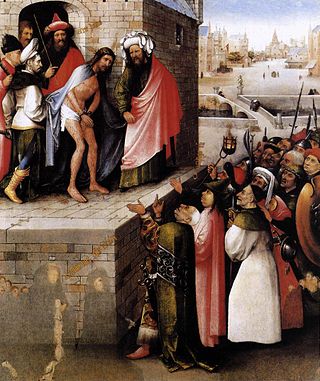
Ecce Homo is a painting of the episode in the Passion of Jesus by the Early Netherlandish painter Hieronymus Bosch, painted between 1475 and 1485. The original version, with a provenance in collections in Ghent, is in the Städel Museum in Frankfurt; a copy is held the Museum of Fine Arts in Boston. The painting takes its title from the Latin words Ecce Homo, "Behold the Man" spoken by the Roman Prefect Pontius Pilate when Jesus is paraded before a baying, angry mob in Jerusalem before he is sentenced to be crucified.
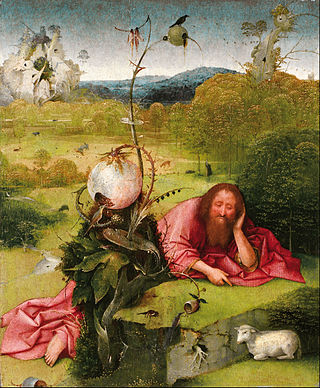
St. John the Baptist in the Wilderness is an oil painting by Hieronymus Bosch, created c. 1489. The painting was acquired by the Spanish collector Lázaro Galdiano in 1913. It is on display in the Lázaro Galdiano Museum, in Madrid, Spain.
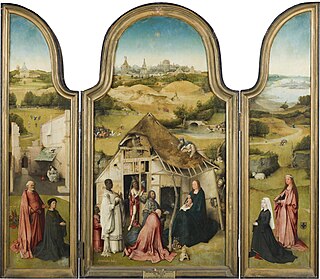
The Adoration of the Magi or The Epiphany is a triptych oil painting on wood panel by the Netherlandish artist Hieronymus Bosch, executed around 1485–1500. It is now in the Museo del Prado in Madrid, Spain.
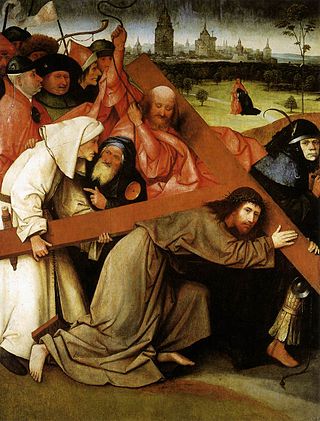
Christ Carrying the Cross is an oil on panel painting by Hieronymus Bosch. The date of this painting is c. 1505–1507. It is held at Palacio Real, in Madrid.

Christ Carrying the Cross is a painting attributed to a follower of Hieronymus Bosch. It was painted in the early 16th century, presumably between 1510 and 1535. The work is housed in the Museum of Fine Arts in Ghent, Belgium. The painting is notable for its use of caricature to provide grotesque-looking faces surrounding Jesus.
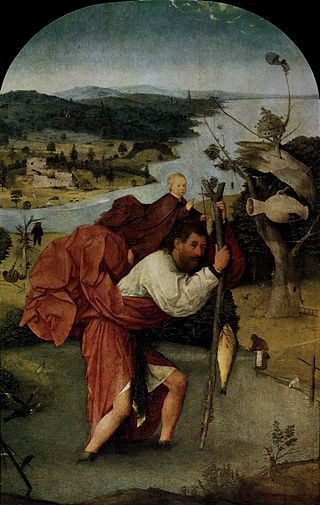
Saint Christopher Carrying the Christ Child is an oil on panel painting by Dutch painter Hieronymus Bosch, dating to c. 1490-1500. It is held at the Museum Boijmans Van Beuningen in Rotterdam.

St. Jerome at Prayer is a painting of St. Jerome by Hieronymus Bosch, thought to have been completed c. 1482. Today it is housed at the Museum of Fine Arts in Ghent.

Christ Crowned with Thorns, sometimes known as Christ Mocked, is an oil on panel painting by Hieronymus Bosch. It is held in the National Gallery in London, which dates it to around 1510, though some art historians prefer earlier dates.

The Crucifixion of Saint Wilgefortis is a c. 1497 triptych by the Early Netherlandish painter Hieronymus Bosch. The subject of the painting has been uncertain, and it has also been known as the Triptych of the Crucified Martyr, or The Crucifixion of Saint Julia, but is now believed to depict Saint Wilgefortis.

The Hermit Saints is a religious oil on panel painting displayed as a triptych, meaning it is one whole painting composed of three separate scenes. This artwork was made by the Renaissance artist Hieronymus Bosch, dating from 1493. The entirety of the triptych painting measures 86 by 60 centimetres. This artwork is currently being housed at the Gallerie dell'Accademia, Venice.

Ecce Homo is a painting by a follower of the Netherlandish painter Hieronymus Bosch. It depicts the presentation of Jesus Christ by Pontius Pilate to the throngs of Jerusalem. Ecce homo is the latin phrase spoken by Pilate, which is where the title comes from. This painting is at the Indianapolis Museum of Art in Indianapolis, Indiana; it is closely similar to one at the Philadelphia Museum of Art.

Christ Child with a Walking Frame is a part of an altarpiece by Netherlandish artist Hieronymus Bosch, painted on the reverse of his Christ Carrying the Cross. Measuring 28 centimetres (11 inches) in diameter, it is at the Kunsthistorisches Museum, Vienna, Austria.
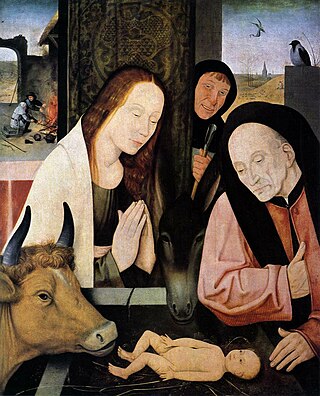
Adoration of the Christ Child is a painting previously attributed to Hieronymus Bosch portraying Mary and the Christ Child. It was created c. 1568, long after Bosch's death. It is held in the Wallraf-Richartz Museum in Cologne.

The Triptych of Temptation of St. Anthony is an oil painting on wood panels by the Early Netherlandish painter Hieronymus Bosch, dating from around 1501. The work portrays the mental and spiritual torments endured by Saint Anthony the Great, one of the most prominent of the Desert Fathers of Egypt in the late 3rd and early 4th centuries. The Temptation of St. Anthony was a popular subject in Medieval and Renaissance art. In common with many of Bosch's works, the triptych contains much fantastic imagery. The painting hangs in the Museu Nacional de Arte Antiga in Lisbon.
Christ Carrying the Cross refers to Jesus's journey to his crucifixion.

















